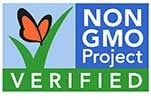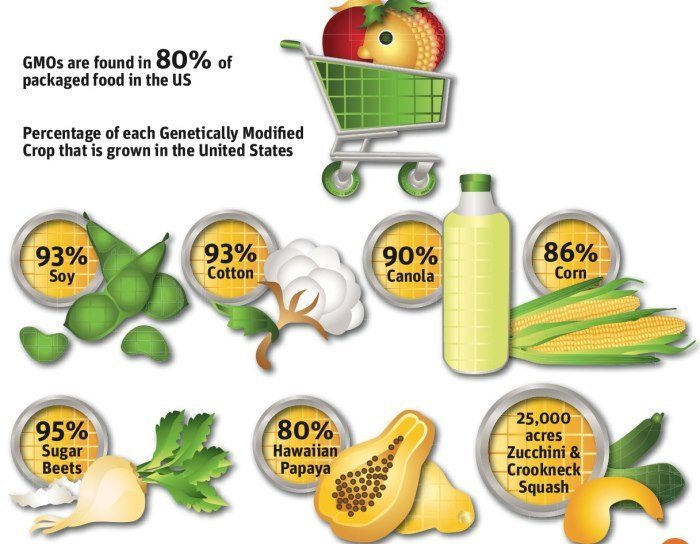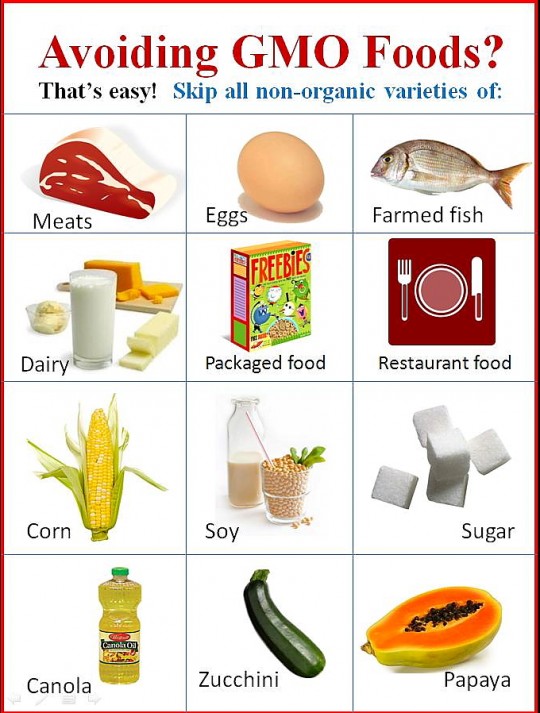Genetically engineered (GE) crops and food ingredients were first introduced during the mid 1990’s. The agricultural chemical industry created GE crops with the promise of significantly higher crop yields. While crop yields may have risen, the contribution of GE technology is a matter of considerable debate. Some groups attribute increased yields to improvements in conventional agriculture (Union of Concerned Scientists, 2009). Any benefits offered by GE technology have been overshadowed by the increased use of toxic pesticides and proliferation of herbicide-resistant weeds.
All of us have the right to know if our food has been genetically engineered. Unfortunately, the U.S. government does not require labeling of GE foods or ingredients to enable shoppers to make informed decisions. However, more than 60 other nations, including France, Germany, Japan, Australia, Russia, China and the United Kingdom, do require GE labeling (Center for Food Safety, 2013a)!
What crops are genetically engineered?
Genetically engineered crops include corn, canola, soybean, sugar beets, and cotton. They are typically used to make ingredients that are added to various food products, such as cornstarch in soups and sauces, corn syrup as a general purpose sweetener, and cottonseed oil, canola oil, and soybean oil in mayonnaise, salad dressings, cereals, breads, and snack foods.
More than 75% of food in supermarkets is genetically engineered or contains GE ingredients (Center for Food Safety 2013b). To avoid GE ingredients, look for the 4 most common GE foods and ingredients:
- Field corn and corn-derived ingredients: The U.S. is the world’s largest corn producer. According to the U.S. Department of Agriculture, American farmers planted more corn last year than any other crop, covering 95 million acres (USDA 2013a). Some 90% of corn grown in the U.S. is GE (USDA 2013b). Most of the crop is field corn cultivated for animal feed, but about 12% is processed into corn flour, high fructose corn syrup, corn starch, masa, corn meal, and corn oil that end up in foods consumed by people (EPA 2013). Consumers should assume that those ingredients in processed food are GE. Less than 1% of the American corn crop is sweet corn, also known as table corn (Iowa State University 2011).
- Soybeans and soybean-derived ingredients: Soybeans are the second most planted American crop, covering more than 76 million acres last year (USDA 2013a). About 93% of soybeans grown in the U.S. have been genetically engineered (USDA 2013b). Soybean-based products and soybean-derived ingredients are common on supermarket shelves. Consumers should assume that products whose labels disclose the presence of soy proteins, soybean oil, soy milk, soy flour, soy sauce, tofu, or soy lecithin have been made with GE ingredients, unless they are certified organic or GE-free.
- Sugar: About 55% of sugar produced in the U.S. comes from sugar beets, 95% of which have been genetically engineered (USDA 2013c). If a product label does not specify that it has been made with “pure cane” sugar, it most probably contains GE beet sugar.
- Vegetable oils: Consumers should assume that vegetable oil, canola oil, cottonseed oil, soybean oil and corn oil are GE. About 90% of American oilseed production is soybeans, which are almost entirely GE (USDA 2013b). The remaining 10% of oilseed crops are cottonseed, sunflower seed, canola, rapeseed, and peanut. Canola and cottonseed oil primarily come from GE varieties. More than 90% of corn oil is made from GE corn.
- Papaya: More than 75% of Hawaiian papaya is GE to resist the ringspot virus (Hawaiian Papaya Industry Association 2013).
- Zucchini and yellow summer squash: A few varieties of squash are GE. Without adequate labeling, it’s hard to spot GE varieties. If you want to be sure, opt for organic varieties.
- Sweet corn: Most sweet corn sold in supermarkets and farm stands is not grown from GE seeds, but a few varieties are, so it’s best to buy organic sweet corn.
- Salmon, flax, plums, potato, radicchio, rice, tomato and wheat: Many other GE foods may be coming soon to a grocery store near you. These have either been approved by the federal Food and Drug Administration (FDA) or are being considered for approval: salmon, flax, plums, potato, radicchio, rice, tomato and wheat (FDA 2014).
- The FDA is considering a producer’s application for GE AquAdvantage salmon: Normal salmon produce growth hormones only in summer months. These fish produce them year-round and grow at twice the normal rate. If the FDA approves AquAdvantage salmon, it will be the first GE animal available in American supermarkets.
- Apples: The FDA faces two other controversial decisions: whether to approve apples genetically modified to not to turn brown when sliced, peeled, or bruised and new varieties of corn and soybean genetically modified to resist the toxic herbicide 2,4-D (USDA 2013e, 2013f).
Reasons to avoid eating genetically engineered ingredients include environmental and human hazards:
- Unintended harm to other organisms: Bacillus thuringiensis (B.t.) is a naturally occurring bacterium that produces crystal proteins lethal to insect larvae. These crystal protein genes have been transferred into corn, enabling corn to produce its own pesticides against insects such as the European corn borer. Studies indicate that pollen from B.t. corn causes high mortality rates in monarch butterfly caterpillars. Although monarch caterpillars consume milkweed plants, not corn, if pollen from B.t. corn is blown by the wind onto milkweed plants in nearby fields, the caterpillars could eat the pollen and perish. Unfortunately, B.t. toxins kill many species of insect larvae; it is not possible to design a B.t. toxin that would only kill crop-damaging pests and remain harmless to all other insects.
- The federal government requires strict safety evaluations before new drugs go on the market but does not mandate similar safety studies for GE crops: Testing for carcinogenicity, harm to fetuses, or risks over the long term to animals and humans is not required for GE foods by the government. Few studies have been conducted by independent scientific institutions.
- Reduced effectiveness of pesticides: Just as some mosquitoes developed resistance to the now-banned pesticide DDT, insects may become resistant to B.t. or other crops that have been genetically-modified to produce their own pesticides.
- Superweeds and more toxic pesticides: Genetically modified, herbicide-tolerant crops have helped to create “superweeds,” pest plants that have mutated to survive herbicides. More than 61 million acres of American farmland are infested with Roundup-resistant weeds (Farm Industry News 2013). A 2012 survey conducted by the marketing research group Stratus Agri Marketing found that nearly half of American farmers reported finding superweeds in their fields (Stratus Agri Marketing 2013). To control these hardy plants, many farmers have resorted to older, more toxic herbicides like dicamba, and 2,4-D. Both dicamba and 2,4-D are known to cause reproductive problems and birth defects and pose increased risks of cancer.
- Increased pesticide use: Herbicide resistance has led to more, not less, herbicide use. According to estimates published in 2012, herbicide-tolerant crops that stimulated superweed growth caused farmers to use 527 million pounds more herbicide between 1996-2011 than would have been the case if those farmers had planted only non-GE crops (Benbrook 2012).
- Cross-contamination and gene transfer to non-target plant species: According to the International Service for the Acquisition of Agri-biotech Applications (ISAAA), a non-profit group that records the global status of biotech crops, almost 70 million hectares of GE crops were planted in the U.S. in 2012 (ISAAA 2012), up from 64 million hectares in 2009 (ISAAA 2009). As GE crops proliferate, many organic farmers must struggle to prevent cross-contamination of their crops by GE seed or pollen spread by wind, insects, floods, and machinery. Unintended GE contamination has become a major issue for organic growers hoping to sell their crops in places that strictly regulate or ban GE foods. It has been estimated that potential lost income for farmers growing organic corn may total $90 million annually (Union of Concerned Scientists 2001).
- Human health risks: Scientists have not determined whether GE food poses risks to human health. However, introducing foreign genes into food plants may have an unexpected and negative impact on the digestive tract, nutrient absorption, metabolism, and overall health. Consuming GE foods also increases our exposure to herbicide and pesticide residues, many of which are neurotoxic, carcinogenetic, associated with behavioral effects, birth defects, genetic mutations, and reproductive problems.
- Extensive testing of GM foods has not been done to avoid the possibility of harm to consumers who have food allergies.
- Increased risk of allergenicity and autoimmune disorders: Many children in the US and Europe have developed life-threatening allergies to peanuts and other foods. The incidence and prevalence of gluten sensitivity, celiac disease, and various autoimmune disorders has been increasing in both human and animal populations in the U.S. during the last 20 years. It is possible that introducing a gene into a plant may create a new allergen or cause an allergic reaction in susceptible individuals.
Until Congress or state governments enact mandatory labeling of GE ingredients in food, how can American shoppers avoid food with GE ingredients?
Buy organic: National and state organic certification rules do not allow GE foods to be labeled “organic.” When you buy organic, you buy food free not only of synthetic pesticides but also GE ingredients:

Buy food certified as “Non-GMO* Project Verified:” The non-profit organization Non-GMO Project operates a detailed, voluntary certification process so that food producers can test and verify that, to the best of their knowledge, they have avoided using GE ingredients in their products. The Non-GMO Project is the only organization offering independent verification for GMO products in the U.S. and Canada (Non-GMO Project 2014):

Use “EWG’s Shopper’s Guide to Avoiding GE Food” to find foods made without ingredients likely to be genetically engineered. Eating only organic and certified GE-free food is not an option for some people. EWG’s Shopper’s Guide to Avoiding GE Food helps consumers find products made without ingredients that are likely to be genetically engineered and decide which products are most important to buy organic or certified GE-free.
[Source: “List of Countries That Banned Genetically Modified Food.” 02/09/15 (www.naturalrevolution.org)]
Contact your state and federal representatives and demand that all foods be clearly labeled if they contain or were developed with any GE ingredients.
*GMO: “genetically modified organism,” a term interchangeable with “genetically engineered” or “GE.”
*Genetically modified (GM) foods: Foods produced from crops that have had specific changes introduced into their DNA using the methods of genetic engineering to enhance desired traits such as increased resistance to herbicides or improved nutritional content. The enhancement of desired traits has traditionally been undertaken through breeding, but conventional plant breeding methods can be very time consuming and are often not very accurate. Genetic engineering, however, can create plants with the exact desired trait very rapidly and with great accuracy.
References:
- Benbrook, C. (2009) Impacts of genetically engineered crops on pesticide use in the U.S.: the first thirteen years. (Source: http://www.organic-center.org/reportfiles/GE13YearsReport.pdf). 01/06/14.
- Benbrook, C. (2012) Impacts of genetically engineered crops on pesticide use in the U.S. – the first sixteen years. Environmental Sciences Europe 2012, 24:24
- Center for Food Safety (2013a) International Labeling Laws. (Source: http://www.centerforfoodsafety.org/issues/976/ge-food-labeling/international-labeling-laws# ). 01/07/14.
- Center for Food Safety (2013b) About Genetically Engineered Foods. (Source: http://www.centerforfoodsafety.org/issues/311/ge-foods/about-ge-foods). 01/07/14.
- Environmental Protection Agency (2013) Major Crops Grown in the United States. (Source: http://www.epa.gov/oecaagct/ag101/cropmajor.html). 12/03/13.
- Environmental Working Group’s (EWG) 2014 Shopper’s Guide to Avoiding Genetically Engineered Food. (Source: www.ewg.org › Research). 02/19/14.
- Farm Industry News (2013) Glyphosate-resistant weed problem extends to more species, more farms. (Source: http://farmindustrynews.com/herbicides/glyphosate-resistant-weed-problem-extends-more-species-more-farm). 12/08/13.
- Food and Drug Administration (2014). Completed Consultations on Bioengineered Foods. (Source: http://www.accessdata.fda.gov/scripts/fcn/fcnNavigation.cfm?rpt=bioListing&displayAll=false&page=1). 01/09/14.
- Hawaiian Papaya Industry Association (2013) Hawaii Grown Papayas: The Rainbow Papaya Story. (Source: http://www.hawaiipapaya.com/rainbow.html). 11/25/13.
- International Service for the Acquisition of Agri-biotech Applications (ISAAA) (2009) Global Status of Commercialized Biotech/GM Crops: 2009 – The First Fourteen Years, 1996 to 2009. (Source: http://www.isaaa.org/resources/publications/briefs/41/executivesummary/default.asp). 01/07/14.
- International Service for the Acquisition of Agri-biotech Applications (ISAAA) (2012) Global Status of Commercialized Biotech/GM Crops: 2012. (Source: http://www.isaaa.org/resources/publications/briefs/44/executivesummary/default.asp). 01/07/14.
- Iowa State University (2011) Corn Production: Common Corn Questions and Answers. (Source: http://www.agronext.iastate.edu/corn/corn-qna.html). 01/07/14.
- “List of Countries That Banned Genetically Modified Food.” 02/09/15 (www.naturalrevolution.org)
- Non-GMO Project (2014) The “Non-GMO Project Verified” Seal. (Source: http://www.nongmoproject.org/learn-more/understanding-our-seal/ ). 01/07/14.
- Stratus Agri Marketing (2013) Glyphosate Resistant Weeds – Intensifying. (Source: http://www.stratusresearch.com/blog07.htm). 01/07/14
- Union of Concerned Scientists (2001) Union of Concerned Scientists Comments to the Environmental Protection Agency on the renewal of BT-Crop Registration. Docket OPP-00678B. (Source: http://web.peacelink.it/tematiche/ecologia/bt_renewal_ucs.pdf). 01/06/14.
- Union of Concerned Scientists (2009) Genetic Engineering has Failed to Significantly Boost U.S. Crop Yields Despite Biotech Industry Claims. (Source: http://www.ucsusa.org/news/press_release/ge-fails-to-increase-yields-0219.html) 01/07/14.
- U.S. Department of Agriculture (2013a) National Statistics by Subject. (Source: http://www.nass.usda.gov/Statistics_by_Subject/index.php). 12/03/13.
- U.S. Department of Agriculture (2013b) Adoption of genetically engineered crops in the U.S. (Source: http://www.ers.usda.gov/data-products/adoption-of-genetically-engineered-crops-in-the-us.aspx#.Up5PL40h0jU). 12/03/13.
- U.S. Department of Agriculture (2013c) US sugar production. (Source: http://www.ers.usda.gov/topics/crops/sugar-sweeteners/background.aspx#.UpN_gI0h0jU). 11/25/13.
- U.S. Department of Agriculture (2013d) Organic 101: Can GMOs be used in organic products. (Source: http://blogs.usda.gov/2013/05/17/organic-101-can-gmos-be-used-in-organic-products/). 12/08/13.
- U.S. Department of Agriculture (2013e) Dow AgroSciences Petitions (09-233-01p, 09-349-01p, and 11-234-01p) for Determinations of Nonregulated Status for 2,4-D-Resistant Corn and Soybean Varieties. Draft Environmental Impact Statement—2013. (Source: http://www.aphis.usda.gov/brs/aphisdocs/24d_deis.pdf). 01/09/14.
- U.S. Department of Agriculture (2013ef) Okanagan Specialty Fruits, Inc.; Availability of Plant Pest Risk Assessment and Environmental Assessment for Determination of Nonregulated Status of Apples Genetically Engineered To Resist Browning. [Docket No. APHIS–2012–0025] Federal Register 78:251 (December 31, 2013) p 79658. (Source: http://www.aphis.usda.gov/brs/fedregister/USDA_20131104.pdf). 01/09/14.


Comments on this entry are closed.